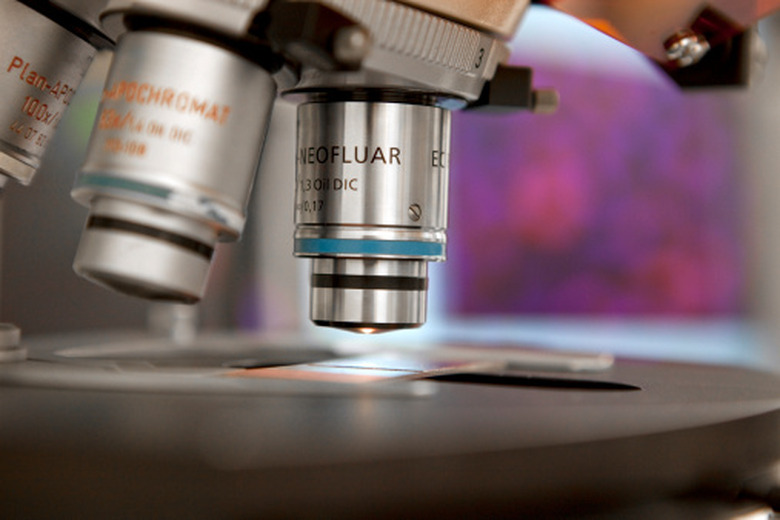How To Use A Microscope To See Cells
Microscopes provide magnification that allows people to see individual cells and single-celled organisms such as bacteria and other microorganisms. Types of cells that can be viewed under a basic compound microscope include cork cells, plant cells and even human cells scraped from the inside of the cheek. When you want to see cells, you have to prepare them in a way that removes obstructions that would block your view and use the microscope properly to bring them into focus.
Prepare Slides
Step 1
Scrape the inside of your cheek with a flat toothpick and wipe the wet end of the toothpick on the center of a glass slide.
Step 2
Hold the slide cover at an angle with its edge touching the edge of the saliva and cheek cells and the rest of the cover poised over the cells. Lower the slide cover slowly to try to avoid trapping air bubbles in the slide.
Step 3
Cut a thin slice off a fresh leaf with a knife. Place it on the other glass slide, add a drop of water and place the slide cover over it as described above.
Use of Microscope
Step 1
Set the microscope on a stable countertop or table and plug it into a nearby outlet. Turn the coarse focus knob to lower the stage as far as possible and turn the microscope's lenses so the shortest one, which is the lowest magnification, is pointing down.
Step 2
Place one of the slides on the microscope stage with the center of the slide over the hole through which the light will shine. Clip it on with the stage clips and turn on the microscope.
Step 3
Look through the eyepiece and turn the rough focus knob until you can clearly see the slide. Center the slide so the cells are in the middle of your field of vision.
Step 4
Rotate the lenses so the next highest magnification is pointing down.
Step 5
Look through the eyepiece again and use the fine focus knob to bring the cells into focus. The coarse focus knob might move the stage too close to the lens at this magnification. If you cannot focus the cells, turn the coarse focus knob only a little bit to avoid damaging the microscope.
Step 6
Rotate to a higher power lens and focus the microscope again to see the cells under even higher magnification.
Things Needed
- Glass slide and slide cover
- Flat toothpick
- Leaf
- Knife
- Water
Cite This Article
MLA
May, Kristen. "How To Use A Microscope To See Cells" sciencing.com, https://www.sciencing.com/use-microscope-see-cells-7443677/. 24 April 2017.
APA
May, Kristen. (2017, April 24). How To Use A Microscope To See Cells. sciencing.com. Retrieved from https://www.sciencing.com/use-microscope-see-cells-7443677/
Chicago
May, Kristen. How To Use A Microscope To See Cells last modified March 24, 2022. https://www.sciencing.com/use-microscope-see-cells-7443677/
